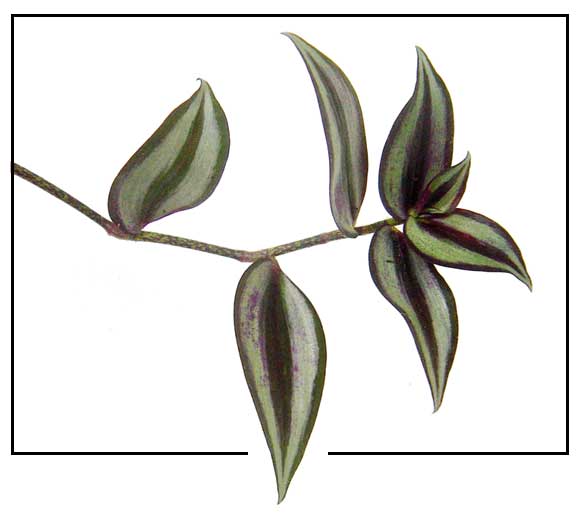|

Gen info
- Tradescantia, commonly known as spiderwort, are herbaceous perennial plants. The genus contains about 75 species, which are either climber or trailer.
Botany
Zebrina pendula is a vigorous branching
creeper with succulent leaves and stems, rooting freely at the nodes.
Leaves are sessile and alternate, ovate and short acuminate, the upper surface dark green to
purple, with 2 longitudinal silver stripes adaxially. The under-surface is dark purple. Flowers
are purple-pink, or white, small and in terminal clusters, supported by two large foliage-like, narrow, ciliate bracts. Sap is mucilaginous and clear.
 Distribution Distribution
- Popular as a ground cover, tending to become invasive, aggressively colonizing new areas when left undisturbed,
-Native to Mexico.
Constituents
- Study isolated three components from Zp: ß-sitosterol, 3β, 5α, 6β-trihydroxy stigmast and succinic acid. (see study below) (7)
- Study isolated
three components viz. ß-sitosterol, 3ß, 5a, 6ß-trihydroxystigmast and succinic acid. (see study below) (3)
- Preliminary phytochemical screening of leaves yielded sterols, saponins, flavonoids, tannins, carbohydrates, proteins and aminoacids
Properties
- Studies have shown anti-proliferative properties.
- Skin irritation may result from repeated contact or prolonged handling of the plant, especially from the clear, watery sap, unique to T. zebrina. (17)
- Studies have suggest antineoplastic, antiarrhythmic, antibacterial, antioxidant, acetylcholinesterase inhibitory properties.
Parts
used
Leaves and stems.
Uses
Edibility
- In Mexico, Matali, a beverage made of lemon and sweetened decoction of leaves, is used as a cold tonic drink.
Folkloric
- No reported
folkloric medicinal use in the Philippines.
- Elsewhere, used for treatment of common cold, hypertension, tuberculosis,
uterine disorders.
- In Jamaica, used for
treatment of high blood pressure, coughs, tuberculosis, and as cold cure.
- In combination with other herbs, used to purify the blood and for amenorrhea.
- In China, leaves applied to reduce swellings. Also used for hemorrhoids, blood in the stools, tuberculous cough, conjunctivitis, kidney infections.
- Leaves mixed with other types of herbs as a blood tonic and to treat amenorrhea.
- In Mexico, used for treating diarrhea.
- Leaf decoction used for diabetes.
- Decoction of leaves used for urinary tract infections and for flushing the kidney.
- In Afro-Cuban Santeria, decoction of leaves drunk to flush gravel out of the kidneys and bladder, break the crisis of colitis, and provoke menstruation. (Cabrera, 1971) (5)
- In Guyana, leaves used as tea for cleansing blood and treating influenza. (10)
Studies
• 3-Ecdysone / Anti-Arrhythmic Effect: Study isolated ß-ecdysone from Z. pendula, and in animals has shown elimination of arrhythmia induced by aconitine. (2)
• Antineoplastic Components: Study isolated three components identified as β-sitosterol, 3β, 5α, 6β-trihydroxy stigmast and succinic acid. Anti-tumor activity was seen in ascites-type-180 sarcoma of mice: 43% (160mg/kg) for succinic acid, 91% (100mg/kg) for β-sitosterol and 98%(100mg/kg) for 3β, 5α, 6β-trihydroxystigmast. (3)
• Anti-Cancer / Anti-Proliferative: Study evaluated the anticancerous properties of Tz extracts against two cancer cell lines, A-549 lung carcinoma and SCC-13y malignant keratinocyte cells. Tz treatment resulted in decreased cellular growth. Tz treatment was also tested on non-cancerous cell line of HFF-human foreskin fibroblasts cells to determine relative toxicity of the extract. Results showed inhibitive effects of Tz extracts on cancerous and non-cancerous cells. (6)
• Antineoplastic Components: Study isolated three components from Zp: ß-sitosterol, 3β, 5α, 6β-trihydroxy stigmast and succinic acid. Anti-tumor rates were 43% (160mg/kg) for succinic acid, 91% (100 mg/kg) for ß-sitosterol, and 98% (100 mg/kg) for 3β, 5α, 6β-trihydroxystigmast in anti-cancer test of ascites type-180 sarcoma of mice. (7)
• Effect on Human Cancer Cells: Study evaluated the anticancer characteristics of Tradescantia zebrina and Tradescantia fluminensis. Study confirmed the general inhibitory effects of T. zebrina and T. fluminensis extracts on cancerous and non-cancerous cells. (8)
• Antioxidant / Antibacterial / Leaves: Study evaluated the antioxidant and antibacterial activity of five Commelinaceae methanolic leaf extracts. Antioxidant activity was evaluated by TPC, TTC, TFC assays, while antioxidant activities were measured by DPPH, FRP, and FIC. Of the five plants, the methanolic leaf extract of T. zebrina showed the highest antioxidant content and activity, and exhibited antibacterial activity against six Gm-positve and two Gm-negative bacterial species. (12)
• Antioxidant / Acetylcholinesterase Inhibitory Activity / Leaves: Study evaluated the in vitro antioxidant and acetylcholinesterase inhibitory activity of methanol extract of leaves of T. zebrina.
The ME of TZ at 100.00 µg/ml and 10.00 µg/ml showed significant inhibition of acetylcholinesterase activity (p<0.05) of 14.0% and 15.3%, respectively. The extract also exhibited 18.1% reduction and capability to scavenge free radical against DPPH. (13)
• Silver Nanoparticles / Antibacterial / Leaves: Study reports on the biosynthesis of silver nanoparticles using aqueous leaf extract of T. zebrina and its antibacterial activity against common human pathogenic bacteria viz. S. epidermis, S. aureus, S. enterica, E. coli and B. cereus. Results showed good zones of inhibition comparable to amikacin. (14)
• !5-Lipoxygenase Inhibition / Leaves: Study evaluated the 15-lipoxygenase inhibitory activity of methanolic leaf extracts of Commelina benghalensis, Tradescantia fluminensis, and Tradescantia zebrina. All the extracts inhibited the action of 15-lipoxygenase at concentration of 0.2 µg/mL. T. fluminensis and Tradescantia zebrina exhibited higher than 50% inhibition. (16)
• Bioactive Compounds for Blood Coagulation / Antimicrobial / Leaves: Extracts of Tradescantia zebrina, Tagetes minuta, ands Codieum variegatum have been reported to be used for blood clotting. Study evaluated the crude extract of these plant species used to accelerate blood clotting. All the extracts were found to be abundant in iron, copper, and phytochemicals. All extracts showed moderate inhibition of E coli and C. albicans, and mild inhibition of S. aureus. The extracts showed trace amounts of vitamin K and moderate amounts of calcium. (18)
Availability
Wild-crafted.
|



 Distribution
Distribution

